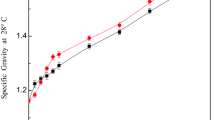Abstract
Red mud emerges as the major waste material during production of alumina from bauxite by the Bayer’s process. Based on economics as well as environmental related issues, enormous efforts have been directed worldwide towards red mud management issues i.e. of utilization, storage and disposal. The present research work has been undertaken with an objective to explore the use of red mud as a reinforcing material in the polymer matrix as a low cost option. The silicate layered red mud was organophilized by aniline formaldehyde and to know the effect of various filler loading on the material properties of PVA-organophilized red mud composites, prepared by a conventional solvent casting technique and comparison of the same with that of the virgin poly (vinyl alcohol) (PVA), various characterizations was done. The modified red mud was typically characterized by X-ray diffraction. The X-ray diffraction pattern of the composite materials was also studied. The morphological image of the composite materials was studied by scanning electron microscopy (SEM). Transmission electron microscopy (TEM) was used to characterize the dispersion of the red mud within the composite materials. The surface topography of the composite materials was studied by Atomic Force Microscopy (AFM). The dielectric properties of composite materials were investigated in wide frequency ranges from 1 MHz to 1 GHz.










Similar content being viewed by others
References
Mitra T (1998) Aluminium industry technology road map for India. In: Sastry DH, Subramanian S, Murthy KSS, Abraham KP (eds) Proceedings of international conference on aluminium (INCAL’98), New Delhi, India, pp 1–27
Thakur RS, Das SN (1994) In: Red mud analysis and utilization, publication and information directorate and Wiley Eastern Limited, New Delhi, India, pp 1–16
Bhat AH, Banthia AK (2007) Improvement of the red mud polymer-matrix composites by organophillization of red mud. Adv Mater Res 29:333–336 (Advanced Materials and Processing IV)
Bhat AH, Banthia AK (2008) Properties of thin film poly (vinyl alcohol) organically modified layered filler materials. J Polym Mater 25(3):325–333
Bhat AH, Banthia AK (2008) Mechanical and dynamical mechanical analysis of poly (vinyl alcohol)-modified inorganic filler composite. Polym Plast Technol Eng 47(2):115–121
Bhat AH, Bhat IH, Mishra RK, Datt M, Banthia AK (2011) Development and material properties of chitosan and phosphomolybdic acid (PMA) based composites. J Compos Mater 45(1):39–49
Huang HH, Orler B, Wilkes GL (1987) Structure-property behavior of new hybrid materials incorporating oligomeric species into sol-gel glasses. 3. Effect of acid content, tetraethoxysilane content, and molecular weight of poly (dimethylsiloxane). Macromolecules 20:1322–1330
Surivet F, Lam TM, Pascault JP, Pham QT (1992) Organic-inorganic hybrid materials. 1. Hydrolysis and condensation mechanisms involved in alkoxysilane-terminated macromonomers. Macromolecules 25:4309–4320
Novak BM, Ellsworth MW (1993) Inverse organic-inorganic composite materials: high glass content non-shrinking sol-gel composites. Mater Sci Eng A162:257–264
Hajji P, David L, Gerard JF, Pascault JP, Vigier G (1999) Synthesis, structure, and morphology of polymer-silica hybrid nanocomposites based on hydroxyethyl methacrylate. J Polym Sci B Polym Phys 37:3172–3187
Shao C, Kim H-Y, Gong J, Ding B, Lee D-R, Park S-J (2003) Fiber mats of poly (vinyl alcohol)/silica composite via electrospinning. Mater Lett 57:1579–1584
Godovsky DY (2000) Device applications of polymer-nanocomposites. Adv Polym Sci 153:163–205
Gangopadhyay R, De A (2000) Conducting polymer nanocomposites: a brief overview. Chem Mater 12:608–622
Saha N, Sedlarik V, Saha P, Kazantseva N, Kar S, Banthia AK (2005) Electromagnetic properties of aluminosilicate-filled polymer composites of poly (vinyl alcohol)–poly (vinyl pyrrolidone). Polym Compos 26:739–744
Ali SKA (2003) Effect of filler on PVA-PVP blend composites. M.Tech dissertation, IIT, Kharagpur, India
Saha N, Ali SKA, Reddy CS, Banthia AK (2004) Electromagnetic properties of aluminosilicate-filled polymer composites of poly (vinyl alcohol)–poly (vinyl pyrrolidone), PPS-20 Polym. In: Proceeding of Society Mtg and 20th anniversary celebration, Paper 132, Akron
Bhat AH, Banthia AK (2007) Characterization preparation of poly (vinyl alcohol) modified red mud composite materials. J Appl Polym Sci 103:238–243
Fornes TD, Paul DR (2003) Modeling properties of nylon 6/clay nanocomposites using composite theories. Polymer 44:4993–5013
Costov I (1982) Mineralogy. Pease State Publishing House, Moscow (In Russian)
Uspenskayia ME, Postychova TV (2004) Mineralogy with crystallography and petrography. Lomonosov State University Publishing House, Moscow (In Russia)
Krupichea S (1976) Physics of ferrite and magnetic oxides. Pease State Publishing House, Moscow (In Russia)
Edelstein AS, Cammarata RC (1996) Nanomaterials: synthesis, properties and applications. Institute of Physics Publishing, Philadelphia
Author information
Authors and Affiliations
Corresponding author
Rights and permissions
About this article
Cite this article
Bhat, A.H., Khalil, H.P.S.A., ul Haq Bhat, I. et al. Dielectric and Material Properties of Poly (Vinyl Alcohol): Based Modified Red Mud Polymer Nanocomposites. J Polym Environ 20, 395–403 (2012). https://doi.org/10.1007/s10924-011-0383-4
Published:
Issue Date:
DOI: https://doi.org/10.1007/s10924-011-0383-4




